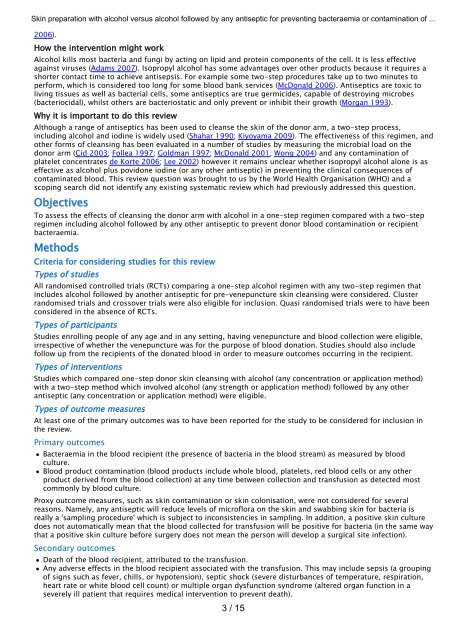Lignes directrices de l'OMS applicables aux prélèvements sanguins ...
Lignes directrices de l'OMS applicables aux prélèvements sanguins ...
Lignes directrices de l'OMS applicables aux prélèvements sanguins ...
Create successful ePaper yourself
Turn your PDF publications into a flip-book with our unique Google optimized e-Paper software.
Skin preparation with alcohol versus alcohol followed by any antiseptic for preventing bacteraemia or contamination of ...<br />
2006).<br />
How the intervention might work<br />
Alcohol kills most bacteria and fungi by acting on lipid and protein components of the cell. It is less effective<br />
against viruses (Adams 2007). Isopropyl alcohol has some advantages over other products because it requires a<br />
shorter contact time to achieve antisepsis. For example some two-step procedures take up to two minutes to<br />
perform, which is consi<strong>de</strong>red too long for some blood bank services (McDonald 2006). Antiseptics are toxic to<br />
living tissues as well as bacterial cells, some antiseptics are true germici<strong>de</strong>s, capable of <strong>de</strong>stroying microbes<br />
(bacteriocidal), whilst others are bacteriostatic and only prevent or inhibit their growth (Morgan 1993).<br />
Why it is important to do this review<br />
Although a range of antiseptics has been used to cleanse the skin of the donor arm, a two-step process,<br />
including alcohol and iodine is wi<strong>de</strong>ly used (Shahar 1990; Kiyoyama 2009). The effectiveness of this regimen, and<br />
other forms of cleansing has been evaluated in a number of studies by measuring the microbial load on the<br />
donor arm (Cid 2003; Follea 1997; Goldman 1997; McDonald 2001; Wong 2004) and any contamination of<br />
platelet concentrates <strong>de</strong> Korte 2006; Lee 2002) however it remains unclear whether isopropyl alcohol alone is as<br />
effective as alcohol plus povidone iodine (or any other antiseptic) in preventing the clinical consequences of<br />
contaminated blood. This review question was brought to us by the World Health Organisation (WHO) and a<br />
scoping search did not i<strong>de</strong>ntify any existing systematic review which had previously addressed this question.<br />
Objectives<br />
To assess the effects of cleansing the donor arm with alcohol in a one-step regimen compared with a two-step<br />
regimen including alcohol followed by any other antiseptic to prevent donor blood contamination or recipient<br />
bacteraemia.<br />
Methods<br />
Criteria for consi<strong>de</strong>ring studies for this review<br />
Types of studies<br />
All randomised controlled trials (RCTs) comparing a one-step alcohol regimen with any two-step regimen that<br />
inclu<strong>de</strong>s alcohol followed by another antiseptic for pre-venepuncture skin cleansing were consi<strong>de</strong>red. Cluster<br />
randomised trials and crossover trials were also eligible for inclusion. Quasi randomised trials were to have been<br />
consi<strong>de</strong>red in the absence of RCTs.<br />
Types of participants<br />
Studies enrolling people of any age and in any setting, having venepuncture and blood collection were eligible,<br />
irrespective of whether the venepuncture was for the purpose of blood donation. Studies should also inclu<strong>de</strong><br />
follow up from the recipients of the donated blood in or<strong>de</strong>r to measure outcomes occurring in the recipient.<br />
Types of interventions<br />
Studies which compared one-step donor skin cleansing with alcohol (any concentration or application method)<br />
with a two-step method which involved alcohol (any strength or application method) followed by any other<br />
antiseptic (any concentration or application method) were eligible.<br />
Types of outcome measures<br />
At least one of the primary outcomes was to have been reported for the study to be consi<strong>de</strong>red for inclusion in<br />
the review.<br />
Primary outcomes<br />
Bacteraemia in the blood recipient (the presence of bacteria in the blood stream) as measured by blood<br />
culture.<br />
Blood product contamination (blood products inclu<strong>de</strong> whole blood, platelets, red blood cells or any other<br />
product <strong>de</strong>rived from the blood collection) at any time between collection and transfusion as <strong>de</strong>tected most<br />
commonly by blood culture.<br />
Proxy outcome measures, such as skin contamination or skin colonisation, were not consi<strong>de</strong>red for several<br />
reasons. Namely, any antiseptic will reduce levels of microflora on the skin and swabbing skin for bacteria is<br />
really a 'sampling procedure' which is subject to inconsistencies in sampling. In addition, a positive skin culture<br />
does not automatically mean that the blood collected for transfusion will be positive for bacteria (in the same way<br />
that a positive skin culture before surgery does not mean the person will <strong>de</strong>velop a surgical site infection).<br />
Secondary outcomes<br />
Death of the blood recipient, attributed to the transfusion.<br />
Any adverse effects in the blood recipient associated with the transfusion. This may inclu<strong>de</strong> sepsis (a grouping<br />
of signs such as fever, chills, or hypotension), septic shock (severe disturbances of temperature, respiration,<br />
heart rate or white blood cell count) or multiple organ dysfunction syndrome (altered organ function in a<br />
severely ill patient that requires medical intervention to prevent <strong>de</strong>ath).<br />
3 / 15

















